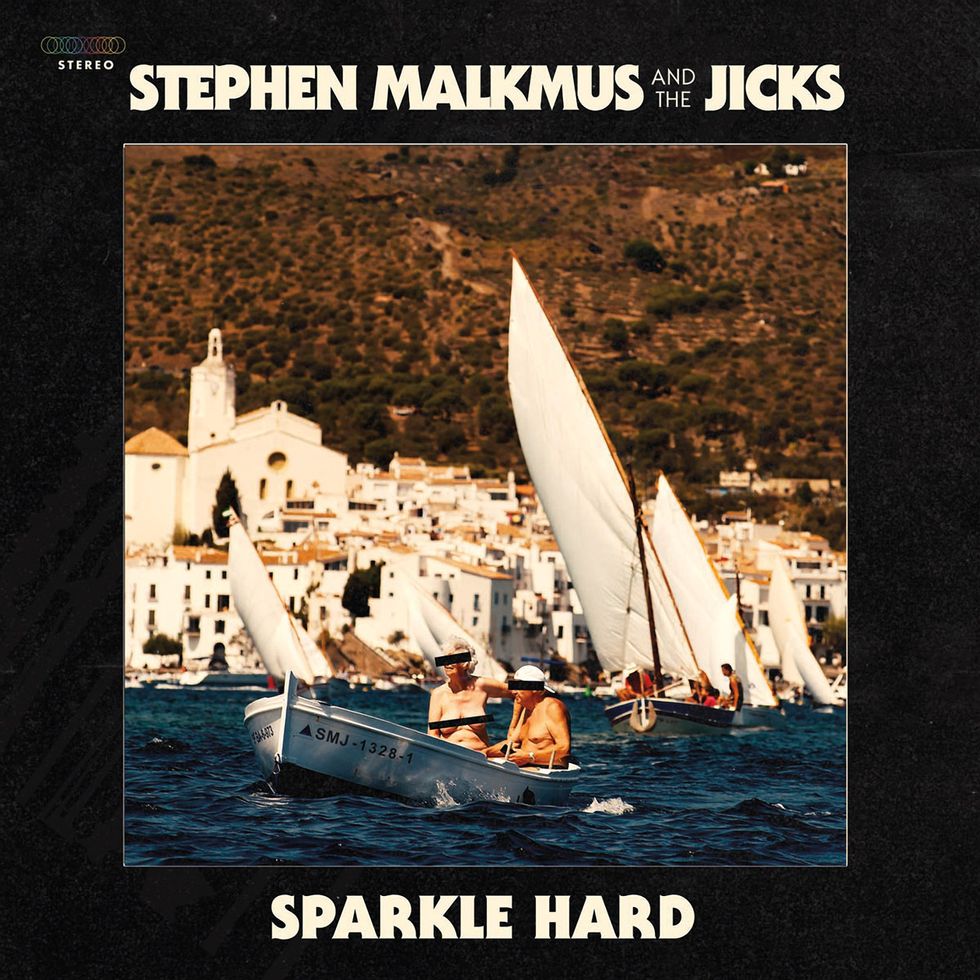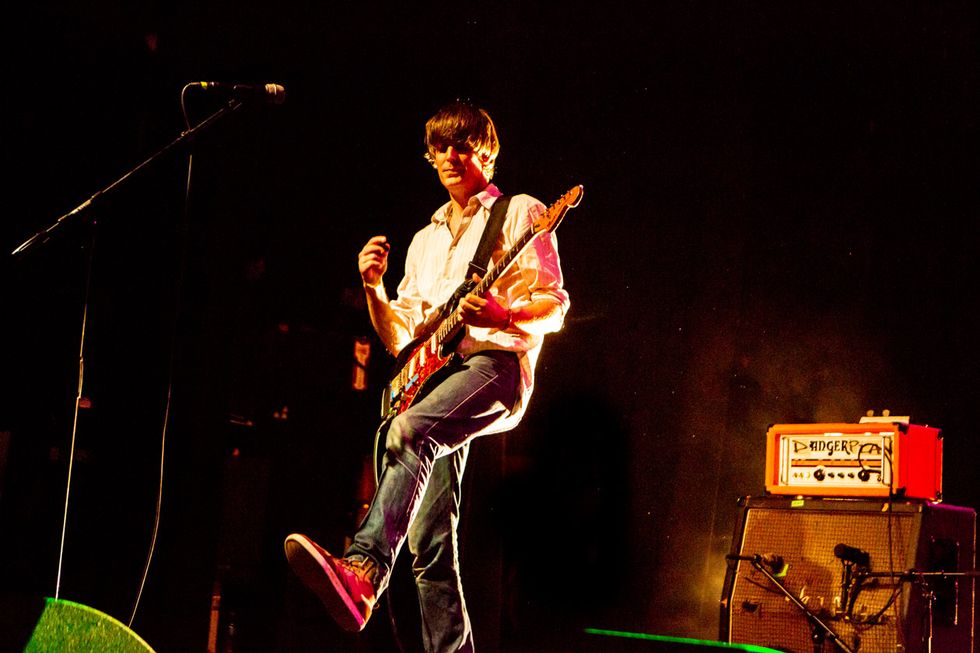In the 1990s, Pavement—a band from Stockton, California, that started strictly as a recording project—emerged as one of the most critically acclaimed indie rock groups of the decade. Singer and guitarist Stephen Malkmus was central to Pavement’s trademark approach: highly literate, oblique lyrics, matched by an off-center bent to the guitar. Solos on songs like “The Hexx” and “Cut Your Hair” showed Malkmus to be not necessarily a skilled guitarist in any obvious sense, but a master of melodic economy and gestural effects, as well as a purveyor of killer, oddball tones.
Shortly after Pavement went on hiatus in 1999, Malkmus continued his concept as a solo artist with a new band, the Jicks. The group, whose most recent lineup includes co-guitarist and keyboardist Mike Clark, bassist Joanna Bolme, and drummer Jake Morris, recently released its seventh album, Sparkle Hard. The first single, “Middle America,” is clearly in the mold of Pavement, but there are plenty of rich new details throughout, like synth-y electric guitar sounds, the unexpected occasional use of Auto-Tune on Malkmus’ vocals, and a country-ish duet (“Refute”) with Kim Gordon, best known for her work with Sonic Youth.
Shortly before the release of Sparkle Hard, Malkmus called from his home in Portland, Oregon, to talk about the peculiarities of his technique (he plays without a pick), his formative years in Stockton, and the handful of trustworthy axes he has used, both with Pavement and the Jicks, in the service of his artistic songs.
Sparkle Hard sounds excellent. What guitars did you play on the album?
Electric-wise I played some I’ve had for a long time, like my Guild S-100, I think it’s called—similar to what that guy from Soundgarden [Kim Thayil] played. I can’t remember who else played one, but they were economical ’70s guitars that are actually really good.
I’m still playing my old Strat. At home, I still play my Travis Bean, and I used it on this song called “Solid Silk.” At the end of the song, I do some solos on there. They’re just plugged directly into Pro Tools, and those Travis Beans have a certain sound. It’s a little unwieldy and heavy to play live, and also mine needs to be serviced. I can handle it in the studio, but maybe not on the road. But those are cool guitars.
What year is the Strat?
It’s a ’73 or ’74. I’ve told the story before of buying it from a friend of mine, who… I don’t know where he got it, but I don’t think that it was on the up and up. But I was 16 and I wasn’t the most on-the-up-and-up person, either. Someone had put two humbucker pickups in it, and I took those out immediately. Even then I knew that was probably a bad idea. I’ve played that guitar forever. It weighs like zero pounds. It’s just a fun guitar to play, and it sounds so cool. But then again, it also needs a little bit of looking after. These old guitars can just be great, but they do need some love. They need somebody who understands what you want and also how they should sound.
I’ve noticed that you don’t play the guitar, not even the electric, with a pick.
I play with my thumb and pointer finger exclusively. That offers me a lot of control, but, of course, people can get a lot of control with their guitar picks, too. There are plenty of outrageous flatpickers. Plus, when you’re working with distortion and compression, you can get away with a lot. You don’t have to hit every note just right, at least not with what I’m going for. But, yeah, that’s something I’ve done for the last 20 years. I’ve kind of abandoned using a pick.
Speaking of distortion, you get some great and varied sounds on the album. Is that all within Pro Tools or did you use stompboxes
No, those are all pedals. [Producer] Chris [Funk, of the Decemberists], he has a shitload of pedals and he split it two ways. There’s his way, my way, and a direct sound, which hypothetically we could’ve used, but for the most part we didn’t. He had his pedals running to one amp and he had a lot more of these ones that make your guitar sound like a synthesizer. I was like, “You go for it and I’m going to do what I do over here with my standard setup.”
On my side, there’s a lot of wah-wah on there—more than I’ve ever used. And I was coming back home to this vintage Mu-Tron volume and wah-wah that I’ve had since 1996. I left it for a while because it does alter the sound, making it more trebly. I have a bunch of EarthQuaker pedals that I was able to borrow from a friend, and I bought some, too: one of the reverb pedals they have, the phaser with an octopus on it, and a fuzz. And I have also a blue Diamond J-Drive pedal. It’s a very simple distortion pedal—very useful, no fail.

TIDBIT: Malkmus played guitar in the control room during the recording of his latest album. “It’s amazing what you can hear and what you can get away with without wearing headphones,” he says.
What would you say is the ratio of his setup to yours on the album?
That’s a good question. It goes song to song. If it sounds really gnarly, it’s more likely his setup. Sometimes we would get over synth-guitar’d and we’d want to back it off. But it’s an awesome sound. He had a pedal from Japan [a Korg Miku Stomp] that makes an anime character’s voice. I didn’t use that, but I was interested in it. Pedals can be quite addictive.
Just so I understand correctly, when you were recording, were you hearing both setups at once or were you only hearing your setup?
Yeah, I was hearing both at once. I stood in the control room with the band. I wore no headphones during the whole recording, so I was just listening to the monitors, and we were trying to develop a group sound in there. And the band sat in the other room, because the drummer and the bass player, they should be together. There’d be no bleed in my vocal. And it was a small room with mirrors and windows. I could see everybody, but they were on the other side of the fence from me, so I could hear everything coming through my vocals. I didn’t have to deal with headphone mixes.
What was it like to record a rock album without cans?
It’s kind of nice to not have to wear headphones in loud rock. You can do it in acoustic music, of course. And actually the room we had was so fancy and quiet that I’ve done some acoustic in there. It’s amazing what you can hear and what you can get away with without wearing headphones.
Hearing these kind of synth sounds from Chris’ setup—did you find it made you play differently than you normally did?
Not really. When I soloed, I just did what I normally do. We went into the studio with some pretty solid demos, which maybe I’ll release some day. If you like us, they’re interesting, but they’re maybe not for the average listener.
I kind of knew what I wanted to add, and I tried to be careful with just adding stuff and building tracks, because with Pro Tools things can get out of hand. You can Frankenstein solos together and spend forever on it. I think the songs are there. They’re going to be there whether I build all these interlocking guitars or not.
Malkmus still frequently plays this early ’70s hardtail Fender Stratocaster, shown here during a 2014 gig with the Jicks at L.A.’s El Rey Theatre. Photo by Debi Del Grande
Talk about your formative years, in Stockton, California.
I just had a Spanish guitar or whatever, a soft-string [nylon-string] guitar. I’d play that and bass. The first thing I played was bass in a punk band called the Straw Dogs. It’s like working in a restaurant, at least in the world of punk. Playing bass in a punk band is kind of like paying your dues by washing dishes in a restaurant.
That’s funny.
They hand you the bass and you just play the root notes and it’s a good place to start. That’s no disrespect to bass players in the world. Our music was so remedial and I didn’t know barre chords and it was easier to downstroke those roots on the bass. Then I started learning some guitar chords. I remember the Jimi Hendrix “Purple Haze” chord [E7#9] and the E7 in [Creedence Clearwater Revival’s] “Born on the Bayou.” And when I learned those chords, however basic they are, I was just like, “Man, that’s amazing.” Those were my first chords … that and playing in the farmer’s corner with the open voicings. It was really fun.
And then some guy taught me “Something” by the Beatles and I learned some diminished chords in standard tuning, just seeing how you could make these countermelodies in chord progressions like that. Another song that really blew me away for some reason was by Ten Years After: “I’d Love to Change the World.” I learned it, and it was like, “Whoa, I’m really good,” probably because it’s easier to play than it sounds. That’s how I kept going—learning things that sounded good but weren’t too difficult to play.
Then, around when I was about 18, I decided to use some drop tunings, like drop D. I read about Keith Richards playing in open-G tuning—very simple—and later I got into Sonic Youth, who used nonstandard tunings extensively. And from then on, I basically only have like 10 percent of my songs in standard tuning.
I played around with tunings, sometimes dropping lower [in terms of pitch] than most players do. I used the tunings to make songs that sounded full when I played by myself. And also the tunings sometimes made it easier to play the bass notes with my thumb while I was doing other things on the higher strings. I could easily make patterns that sounded unique to me. I pretty much haven’t progressed far from that. Like most of us with our musical taste, it solidifies around adolescence and our young adulthood, and that’s where I’ve been for years.
You mentioned ditching the pick, so there must be at least some way that your playing has evolved since the Pavement years.
Yeah, that’s true. When I first started, there was certainly a lot of hitting a pedal and just doing a scratchy kind of sound with a pick—just going as fast as I could and creating a kind of beehive effect. That sounded rocking to me and, again, I was usually playing very simple solos that were sometimes just one or two notes.

Guitars
1970s hardtail Fender Stratocaster
Guild S-100
Travis Bean TB1000S
Amps
Benson Chimera 30-watt
Orange Retro 50
Effects
Diamond J-Drive Mk3
EarthQuaker Hoof Reaper dual fuzz
EarthQuaker Dispatch Master delay and reverb
EarthQuaker The Depths optical vibrato
Mu-Tron volume/wah
Benson Tall Bird spring reverb
Strings and Picks
Various D’Addario sets
Later on, I realized that on electric guitar, one of the most fun things to do is to bend into notes—starting on a note that’s different than the target note. Plus, when you’re bending, you can create your own slightly out-of-tune sound for an interesting effect.
On the other hand, I’ve tried to keep a bit of naiveté in how I approach the guitar. There’s a benefit in not knowing what I’m going to do. It can certainly help keep things fresh. Also, at this point I try not to play too much. I’m totally blown away by watching really intense guitarists that are incredibly good at playing the instrument, but I guess I’m going for a different feeling. They’re both valid. I’m more into fewer notes—kind of in the manner of Neil Young—less notes and more emotion.
Earlier you mentioned Sonic Youth. Talk about what it was like to work with Kim Gordon on “Refute.”
Kim is a friend from over the years. Pavement toured with her, and I kept in touch. “Refute” was kind of a country-style song. I sang it and it sounded fine, but it just seemed to call for someone outside of the band to sing on it as well. I reached out to Kim, she listened to the song, and she said, “These lyrics are funny. I’ll do it.”
I was really happy that she was willing to collaborate. She’s just not afraid. She maybe had a sip of tequila or something, and she just did it in 15 minutes, in just three takes, which were actually all good. She plays guitar, too. She’s like, “You really should use this amp.” Sometimes I’m surprised when people are into gear, because I’m somewhat into gear but not full gear. I’m just low gear. I thought she was low gear, but she’s not. She’s medium gear.
That’s a funny way to put it. Each tune on Sparkle Hard seems to have its own sound world: “Middle America” is kind of stripped-down pop, “Shiggy” is kind of deep fuzz with what sounds like Mellotron, and so on. When you’re writing, what comes first—the sonic environment or the song form, chords, and lyrics?
I usually get the chords and the melody going first, not lyrics. But then this time I ran a lot of these songs through multiple demos, different paces—like slow, fast, country, more rock—and I’d present things to the band and say, “What do you like?” And they’d hear me sing it. They didn’t listen for the lyrics, but they’d hear how I wanted to play it and I’d hear how they wanted to play it. But, yeah, it’s preconceived, I guess, more so than the early days when I’d just bash it out. And also, in the very early days of Pavement, we didn’t even make demos.
But yeah, now, for whatever reason—maybe it’s either because I’m trying harder or I’m less decisive—it’s turning out that I’ll run through a bunch of different tempos and different keys. It’s probably stuff that a lot of people do all the time, but it’s relatively new to me. And I’ve also come to like to do a little more data research and get feedback about what people like—even if it’s only like my three bandmates.
In this May 21, 2018, performance, Stephen Malkmus’ guitar is front and center, displaying a keening lead tone on “Shiggy” from the new Sparkle Hard album. Check out his thumb-and-index-finger picking approach on his Guild S-100.













![Rig Rundown: Russian Circles’ Mike Sullivan [2025]](https://www.premierguitar.com/media-library/youtube.jpg?id=62303631&width=1245&height=700&quality=70&coordinates=0%2C0%2C0%2C0)












![Rig Rundown: AFI [2025]](https://www.premierguitar.com/media-library/youtube.jpg?id=62064741&width=1245&height=700&quality=70&coordinates=0%2C0%2C0%2C0)




















 Zach loves his Sovtek Mig 60 head, which he plays through a cab he built himself at a pipe-organ shop in Denver. Every glue joint is lined with thin leather for maximum air tightness, and it’s stocked with Celestion G12M Greenback speakers.
Zach loves his Sovtek Mig 60 head, which he plays through a cab he built himself at a pipe-organ shop in Denver. Every glue joint is lined with thin leather for maximum air tightness, and it’s stocked with Celestion G12M Greenback speakers.











